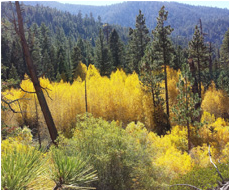 The golden aspen, which goes by the scientific name populus tremuloides, is a deciduous tree present in the San Bernardino Mountains.
The golden aspen, which goes by the scientific name populus tremuloides, is a deciduous tree present in the San Bernardino Mountains.
Golden aspens have tall trunks, with smooth pale bark, sometimes scarred with black. Their glossy green leaves become golden to yellow in autumn. The species often propagates through its roots to form large clonal groves originating from a shared root system. These roots are not rhizomes, as new growth develops from advantitious buds on the parent root system, known as an ortet.
While the populus tremuloides is the most widely distributed tree in North America, it is relatively rare in Southern California.
The tree’s leaves sometimes quake or tremble, which is due to its flexible petioles that are flattened from side to side along their entire length.
The aspen is a tall, fast growing tree, usually 65 to 80 feet at maturity, with a trunk 8 inches to 2 feet 7 inches. The largest recorded specimen is 119 feet 9 inches in height and 4 feet 6 inches in diameter.
The bark is relatively smooth, colored greenish-white to gray, and is marked by thick black horizontal scars and prominent black knots. The leaves on mature trees are nearly round, 1 1⁄2 to 3 1⁄4 inches in diameter with small rounded teeth, and a 1 1⁄4 to 2 3⁄4-inch long, flattened petiole. Young trees and root sprouts have much larger nearly triangular leaves, 4 to 8 inch long.
Aspens are dioecious, with separate male and female clones. The flowers are catkins 1 1⁄2 to 2 1⁄4 inches long, produced in early spring before the leaves; The fruit is a 4-inch pendulous string of 1⁄4-inch capsules, each capsule containing about ten minute seeds embedded in cottony fluff, which aids wind dispersal of the seeds when they are mature in early summer.
In the western United States, this tree rarely survives at elevations lower than 1,500 feet, due to hot summers experienced below that elevation, and is generally found at 5,000–12,000 feet.
The aspen propagates itself primarily through root sprouts, and extensive clonal colonies are common. Each colony is its own clone, and all trees in the clone have identical characteristics and share a single root structure. A clone may turn color earlier or later in the fall than its neighboring aspen clones. Fall colors are usually bright tones of yellow; in some areas, red blushes may be occasionally seen. Aspens do produce seeds, but seldom grow from them. Pollination is inhibited by the fact that aspens are either male or female, and large stands are usually all clones of the same sex. Even if pollinated, the small seeds (three million per pound) are only viable a short time as they lack a stored food source or a protective coating.
Aspen bark contains a substance that was extracted by indigenous North Americans and European settlers of the western U.S. as a quinine substitute.
Like other poplars, aspens make poor fuel wood, as they dry slowly, rot quickly, and do not give off much heat. They are still widely used in campgrounds because they are cheap and plentiful. They are not widely used as building lumber. Pioneers in the North American west used them to create log cabins and dugouts, though they were not the preferred species.
The leaves of the quaking aspen and other species in the genus Populus serve as food for caterpillars of various moths and butterflies.
SBCSentinel
News of note from around the largest county in the lower 48 states.
